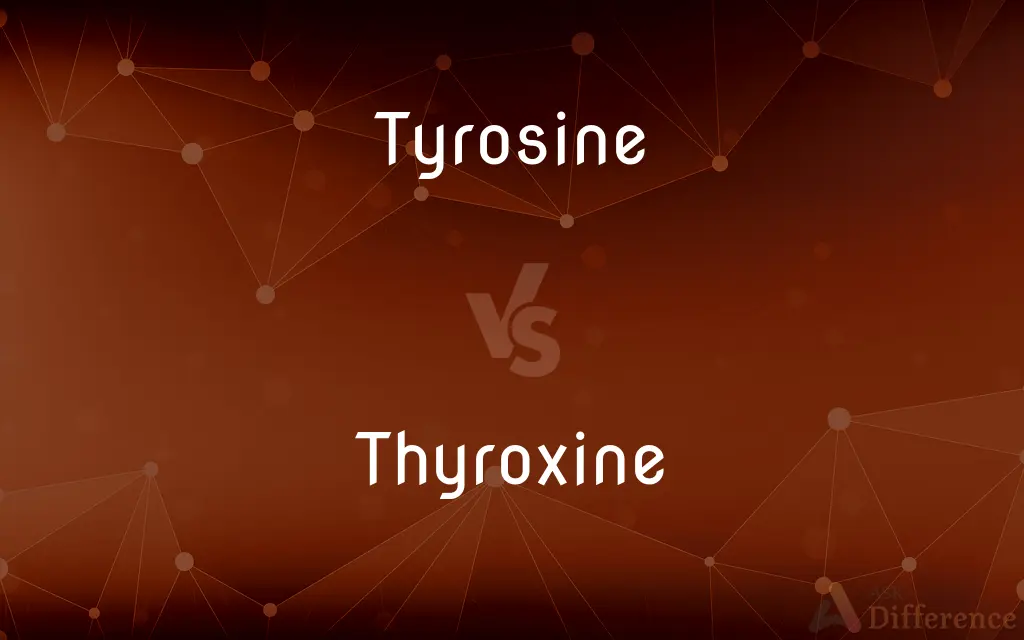Tyrosine vs. Thyroxine — What's the Difference?
By Maham Liaqat & Fiza Rafique — Published on June 22, 2024
Tyrosine is an amino acid crucial for protein synthesis and neurotransmitter production, while thyroxine (T4) is a thyroid hormone derived from tyrosine, essential for regulating metabolism.

Difference Between Tyrosine and Thyroxine
Table of Contents
ADVERTISEMENT
Key Differences
Tyrosine is a non-essential amino acid that plays a vital role in the body's production of proteins, neurotransmitters (such as dopamine and norepinephrine), and hormones, including thyroxine itself. It is found in various foods, including cheese, soy products, and meats, and can also be synthesized by the body from another amino acid, phenylalanine. On the other hand, thyroxine, also known as T4, is a hormone produced by the thyroid gland, using tyrosine as a building block. It is critical for controlling the body's metabolic rate, influencing processes like heart rate, body temperature, and growth.
Tyrosine's significance extends beyond being a precursor to thyroxine; it is also involved in the synthesis of melanin, the pigment responsible for the color of skin and hair. In contrast, thyroxine's primary function is metabolic regulation, with its levels in the body meticulously controlled by the thyroid-stimulating hormone (TSH) from the pituitary gland. An imbalance in thyroxine levels can lead to disorders such as hypothyroidism or hyperthyroidism, affecting numerous bodily functions.
The body's ability to convert tyrosine into thyroxine and other hormones highlights the interconnectedness of nutritional intake and hormone regulation. Adequate dietary consumption of tyrosine-rich foods is essential for optimal hormone production, including thyroxine. Conversely, the synthesis of thyroxine from tyrosine underscores the importance of tyrosine not just as a dietary component but as a critical precursor in metabolic regulation mechanisms.
While tyrosine is accessible through diet and internal synthesis, the production of thyroxine is a complex process involving iodine and the enzymatic actions within the thyroid gland. This process illustrates the layered complexity of biological systems where simple dietary components can lead to the synthesis of crucial regulatory hormones.
Both tyrosine and thyroxine are essential for healthy body function, while they serve distinct roles: tyrosine as a versatile amino acid involved in multiple synthesis pathways, and thyroxine as a key hormone in metabolic regulation. Their relationship exemplifies the intricate biochemical pathways that sustain life, from nutrient intake to hormone production and regulation.
ADVERTISEMENT
Comparison Chart
Classification
Amino acid
Thyroid hormone
Primary Function
Protein synthesis, neurotransmitter production
Metabolic regulation
Source
Diet, internal synthesis from phenylalanine
Synthesized in the thyroid gland from tyrosine
Role in Body
Precursor to hormones, melanin synthesis
Controls metabolic rate, influences heart rate, body temperature
Dietary Sources
Cheese, soy products, meats
Not directly obtained from diet, depends on tyrosine and iodine intake
Impact on Health
Essential for neurotransmission, enzyme function
Critical for growth, development, and metabolic processes
Regulation
Dietary intake, enzymatic conversion
TSH from the pituitary gland controls its levels
Associated Disorders
Deficiency can affect hormone production, mental health
Hypothyroidism, hyperthyroidism due to imbalance
Compare with Definitions
Tyrosine
Tyrosine is a non-essential amino acid involved in protein and neurotransmitter synthesis.
Tyrosine is a precursor to dopamine, enhancing mood and cognitive function.
Thyroxine
Thyroxine is a thyroid hormone essential for metabolic regulation.
Thyroxine influences how the body consumes oxygen and produces heat.
Tyrosine
It can be synthesized by the body from phenylalanine.
In phenylketonuria (PKU), monitoring phenylalanine intake is crucial to manage tyrosine levels.
Thyroxine
Thyroxine affects heart rate and body temperature.
Adequate levels of T4 ensure normal heart functioning and thermal regulation.
Tyrosine
Tyrosine aids in the production of melanin.
Melanin's synthesis from tyrosine contributes to skin and hair color.
Thyroxine
It is synthesized from tyrosine in the thyroid gland.
The production of T4 requires iodine and enzymatic action on tyrosine.
Tyrosine
Tyrosine is a precursor to thyroid hormones.
The thyroid gland uses tyrosine to synthesize thyroxine (T4).
Thyroxine
Imbalance in T4 can lead to thyroid disorders.
Low thyroxine levels can cause hypothyroidism, leading to fatigue and weight gain.
Tyrosine
It is found in high-protein foods.
Consuming chicken or fish provides a healthy dose of tyrosine.
Thyroxine
Thyroxine's levels are regulated by TSH.
An increase in TSH stimulates the thyroid gland to produce more thyroxine.
Tyrosine
A nonessential amino acid, C9H11NO3, that is produced in the body from phenylalanine and is a precursor of melanin and of several neurotransmitters and hormones, such as epinephrine and thyroxine.
Thyroxine
An iodine-containing hormone, C15H11I4NO4, produced by the thyroid gland, that increases the rate of cell metabolism and regulates growth. A synthetic form is used in the treatment of thyroid disorders.
Tyrosine
(amino acid) A nonessential amino acid 2-amino-3-(4-hydroxyphenyl)propanoic acid found in most animal proteins, especially casein
Thyroxine
(hormone) A hormone (an iodine derivative of tyrosine), produced by the thyroid gland, that regulates cell metabolism and growth.
Tyrosine
An amino acid found in most proteins; a precursor of several hormones
Thyroxine
Hormone produced by the thyroid glands to regulate metabolism by controlling the rate of oxidation in cells;
Thyroxine is 65% iodine
Common Curiosities
What is the relationship between tyrosine and thyroxine?
Tyrosine is an amino acid that serves as a precursor for the synthesis of thyroxine, a crucial thyroid hormone.
Why is tyrosine considered non-essential?
Tyrosine is considered non-essential because it can be synthesized by the body from phenylalanine, another amino acid.
How do tyrosine and thyroxine affect mental health?
Tyrosine is a precursor to neurotransmitters affecting mood and cognitive function, while thyroxine's regulation of metabolism can impact overall brain function and mood.
Can dietary changes influence thyroxine levels?
While diet directly influences tyrosine levels, thyroxine levels depend on iodine intake and thyroid health, rather than direct dietary sources of the hormone.
Can you obtain thyroxine from the diet?
No, thyroxine is synthesized in the body from tyrosine and iodine; it is not directly obtained from the diet.
What role does iodine play in thyroxine production?
Iodine is essential for the synthesis of thyroxine in the thyroid gland, combining with tyrosine to form the hormone.
How do the roles of tyrosine and thyroxine differ in the body?
Tyrosine is versatile, serving roles in protein and neurotransmitter synthesis, while thyroxine specifically regulates the body's metabolic rate.
What happens if you have too much or too little thyroxine?
Imbalances in thyroxine can lead to hypothyroidism (too little) or hyperthyroidism (too much), affecting numerous bodily functions.
Is it possible to increase tyrosine levels through diet?
Yes, consuming foods rich in protein can increase tyrosine levels in the body.
What are the signs of a thyroxine imbalance?
Signs can include weight changes, altered energy levels, temperature sensitivity, and mood fluctuations.
Share Your Discovery

Previous Comparison
Concrete Spalling vs. Concrete Scaling
Next Comparison
Triamcinolone vs. HydrocortisoneAuthor Spotlight
Written by
Maham LiaqatCo-written by
Fiza RafiqueFiza Rafique is a skilled content writer at AskDifference.com, where she meticulously refines and enhances written pieces. Drawing from her vast editorial expertise, Fiza ensures clarity, accuracy, and precision in every article. Passionate about language, she continually seeks to elevate the quality of content for readers worldwide.












































